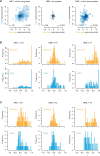Insights into the evolution of symbiosis gene copy number and distribution from a chromosome-scale Lotus japonicus Gifu genome sequence
- PMID: 32658273
- PMCID: PMC7508351
- DOI: 10.1093/dnares/dsaa015
Insights into the evolution of symbiosis gene copy number and distribution from a chromosome-scale Lotus japonicus Gifu genome sequence
Abstract
Lotus japonicus is a herbaceous perennial legume that has been used extensively as a genetically tractable model system for deciphering the molecular genetics of symbiotic nitrogen fixation. Our aim is to improve the L. japonicus reference genome sequence, which has so far been based on Sanger and Illumina sequencing reads from the L. japonicus accession MG-20 and contained a large fraction of unanchored contigs. Here, we use long PacBio reads from L. japonicus Gifu combined with Hi-C data and new high-density genetic maps to generate a high-quality chromosome-scale reference genome assembly for L. japonicus. The assembly comprises 554 megabases of which 549 were assigned to six pseudomolecules that appear complete with telomeric repeats at their extremes and large centromeric regions with low gene density. The new L. japonicus Gifu reference genome and associated expression data represent valuable resources for legume functional and comparative genomics. Here, we provide a first example by showing that the symbiotic islands recently described in Medicago truncatula do not appear to be conserved in L. japonicus.
Keywords: comparative genomics; expression atlas; legume; rhizobium; symbiosis.
© The Author(s) 2020. Published by Oxford University Press on behalf of Kazusa DNA Research Institute.
Figures



References
-
- Parniske M. 2008, Arbuscular mycorrhiza: the mother of plant root endosymbioses, Nat. Rev. Microbiol., 6, 763–75. - PubMed
-
- Ito M., Miyamoto J., Mori Y., et al.2000, Genome and chromosome dimensions of Lotus japonicus, J. Plant Res., 113, 435–42.
-
- Handberg K., Stougaard J.. 1992, Lotus japonicus, an autogamous, diploid legume species for classical and molecular genetics, Plant J., 2, 487–96.
-
- Schauser L., Roussis A., Stiller J., Stougaard J.. 1999, A plant regulator controlling development of symbiotic root nodules, Nature, 402, 191–5. - PubMed
MeSH terms
LinkOut - more resources
Full Text Sources
Other Literature Sources
Research Materials

